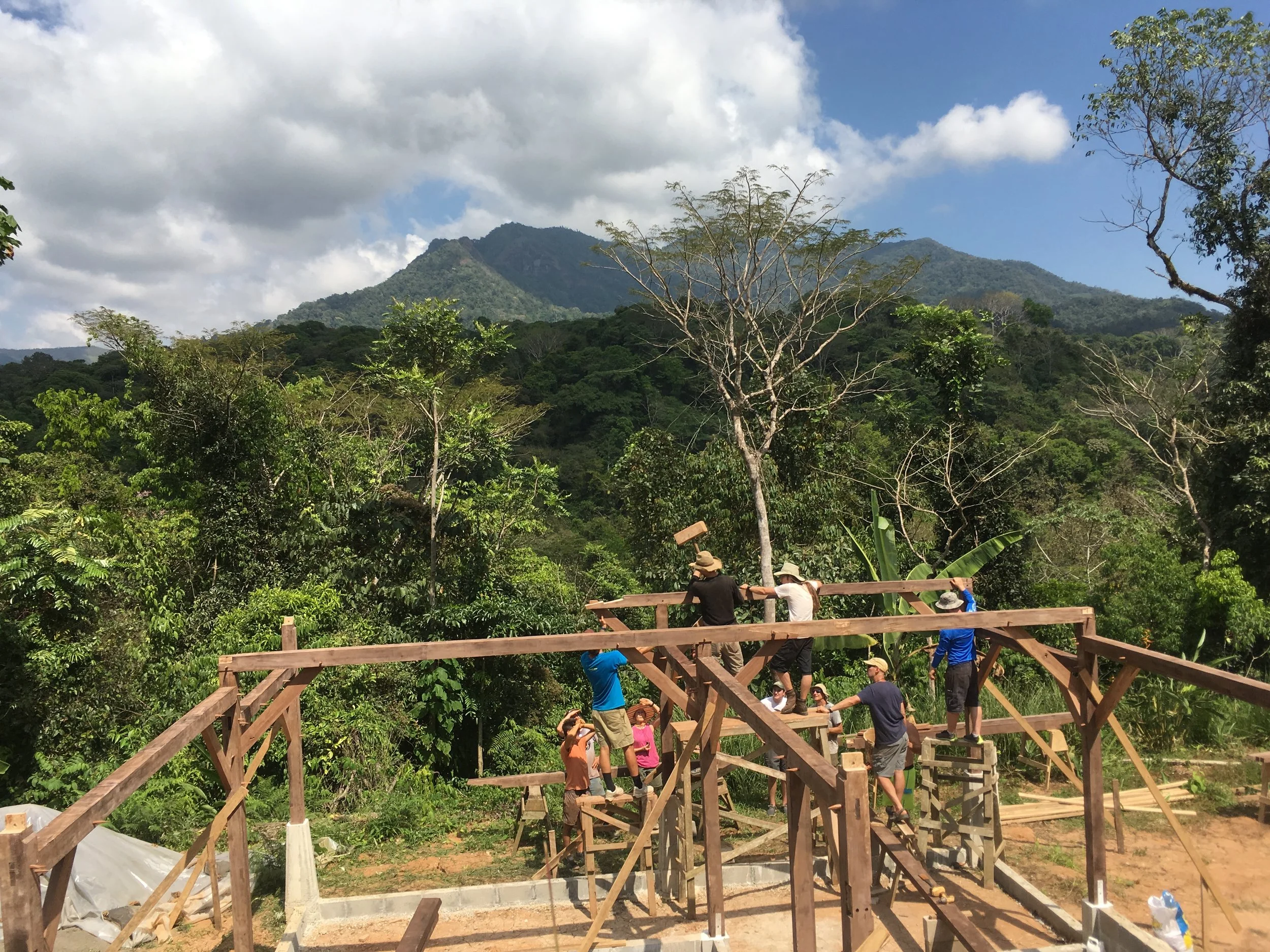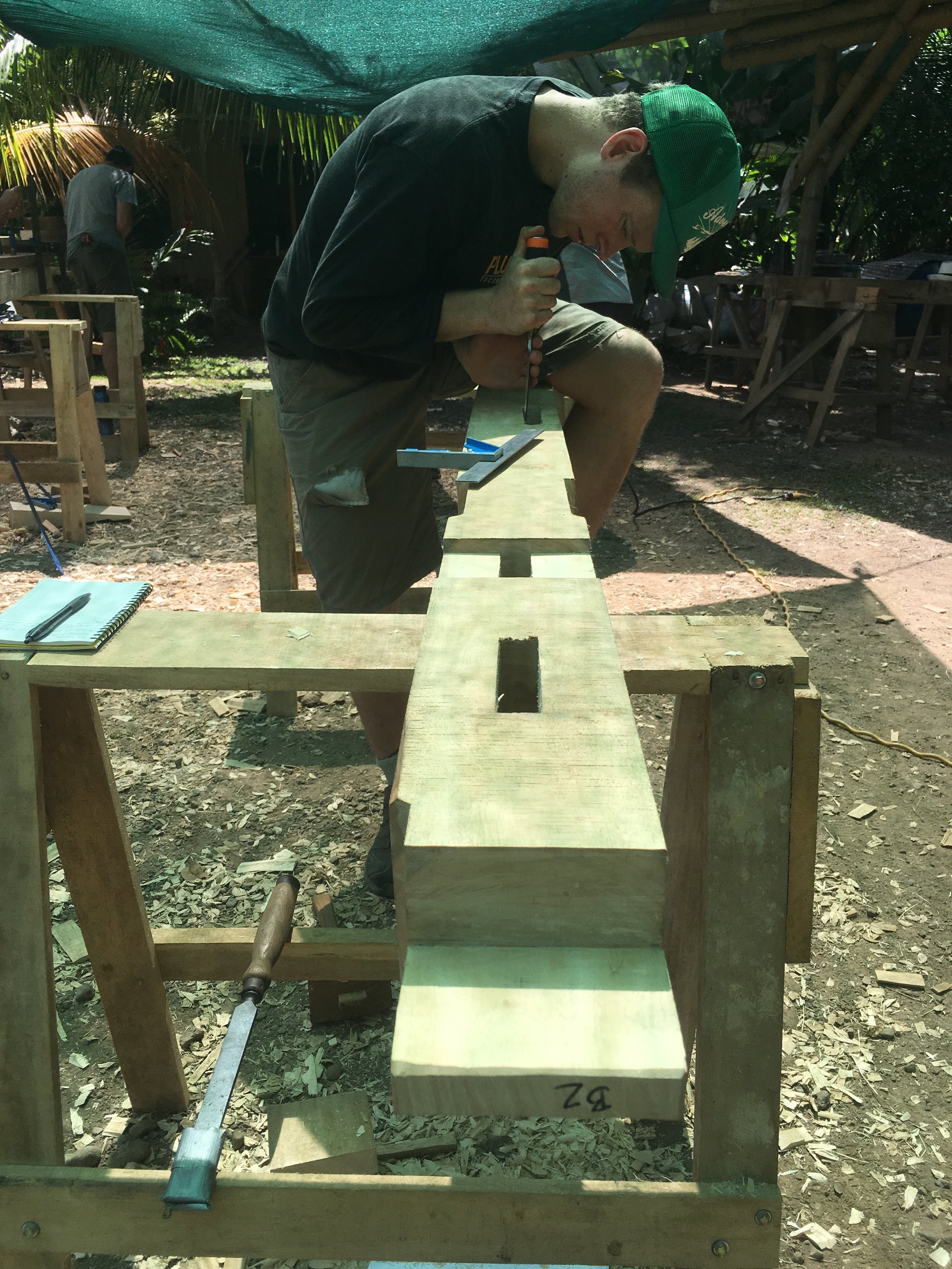Timber Framing in the Tropics
By Tim O'Hara
The rainforests of Central America might not be the first place that you think of when you hear the term “timber frame construction”, but with initiatives in Monteverde and Mastatal, Costa Rica is starting to make a name for itself in the region for this post and beam building technique. We started to build the infrastructure of Rancho Mastatal Sustainability Education Center in the small rural community of Mastatal, Costa Rica in 2001. At that time, we did not seriously contemplate this age-old technique of joining large timbers using mortise and tenon joinery. There were no local, established wood mills in the area in 2001 nor had we ever built anything in this manner. In addition, the portable Alaskan mills used by local sawyers are not up to the task of producing a 6'x6'x12' member straight enough to work using the square rule method that we would eventually be introduced to.
The possibility of building a timber frame structure on the Ranch's campus began to gain traction after our introduction to SKIP DEWHIRST and LIZABETH MONIZ in 2003 when these two Vermont-based builders came to Rancho Mastatal to teach a natural building workshop at our site offered through Yestermorow Design/Build School. After a successful first workshop, they began coming down every year to teach courses, though with a non-timber frame focus. Skip, a seasoned timber framer, eventually started to inquire about the possibility of sourcing long, straight, large timbers so that we could begin to incorporate this type of building into our natural building education programming and our infrastructure. During a conversation in 2006, we decided together to give it a try and started planning a 2007 workshop that would focus on the construction of a 10'x15' cabin on the edge of the rainforest. We would in due course call it La Casucha, meaning little rustic house in Spanish. We set about trying to source the cut list for the design that Skip had come up with. When we finally received the wood delivery for the class, banano was the first term I heard uttered by our talented and local worker ALEX HERNANDEZ. Banano in Spanish, as you can probably figure out, means banana in English and is not an endearing term when referring to a piece of wood to be used for the construction of a rectilinear home. It took us more time to plane the timbers to ready them for laying out the joinery than it did to actually cut the joinery with our chisels and mallets. Banano has since worked its way into our building lexicon and is uttered a bit more frequently than we'd like. But that's life in the rural tropics.
For those of you reading this in the comforts of your first world home, we do not have access to a lumber yard or a box store for our building needs. Nor at that time did we have easy access to a bandsaw mill. Almost all of the wood that we used for building purposes had to be straightened, planed and cut before even thinking about a layout. Fortunately for us and others interested in sourcing local wood, in 2010, a local man named CARLOS SOTO set up a portable bandsaw mill about a ½ mile from our town center. From that point forward we were able to more consistently obtain reasonably straight timbers and our foray into timber framing has not waned since. We now have a combined total of 9 timber frame buildings at the Ranch and in our small community. The practice has revolutionized the infrastructure of our organization and how we look at wood as a building material in our timber-rich ecosystem.
We have access to and have used many different species of wood for our projects and continue to learn about the different qualities that each have. There is much less written about the characteristics of the tropical woods that we use than the commonly used temperate species in North America. Much of our learning has happened through trial and error. Pilon, or bull's blood, is a heavy, resistant hardwood that we expected would be good for pegs until we realized how short-grained it was. Melina, a resistant softwood species originally imported from India, is a decent candidate for frames though the wood can be tricky to work with due to inconsistent grain patterns. Teak, another non-native wood increasingly common in Costa Rica, has a tendency to be knotty from some local suppliers and prone to termite damage if harvested too young, as is commonly done in our area. For most of the species that we've used, sourcing wood from older trees, keeping your chisel razor sharp and making sure that your stock of patience is full are all keys to a successful and strong frame.
Since opening our doors in 2001, natural building has been one of our focuses. Our site is considered by some to be a leader in the relatively small natural building movement in Central America. All of our buildings are small, simple and nice on the eye with a focus on using materials that we can source in our region. To do this requires a lot of work, an abundance of persistence, and the willingness to slow down the building process. As our campus has organically grown, so has our network of people working in and interested in natural building. We've had the honor of working with and befriending a number of leaders in the sector including BILL, BENITO and ATHENA STEEN, RYAN CHIVERS, LIZ JOHNDROW, MATTS MYHRMAN, CHRIS MAGWOOD, SKIP and LIZABETH and others. We've also had the privilege of experimenting with other wonderful natural building resources such as clay, bamboo and lime that are so rich in our region. It's been a wild ride full of successes and failures but increasingly our infrastructure is starting to catch the eyes and fill the hearts of many a natural building lover with timber frame construction the crux of our building world. Even though this building technique has a shorter history in Central American compared to other parts of the world, our experience has shown that it's a relevant choice for our environ. We plan on continuing our experiments with timber frame construction and invite you to come and join us on our ride to discovering the beauty of building in the tropics. Hope to see you in Mastatal soon!
OPPORTUNITIES AT THE RANCH, IN THE REGION AND BEYOND
Japanese Natural Plastering
Interested in natural plasters? Join us in March, 2018 for a unique experience learning about Japanese Plastering at Rancho Mastatal.
Aerie Backcountry Medicine Semester in Wilderness Medicine
Join Aerie for its Semester in Wilderness Medicine at Ranch Mastatal and Montana this winter and spring. The field portion of this course runs January 31 through April 15th. The Semester offers 15 upper-division UM credits, EMT, Wilderness EMT, Swiftwater Rescue and Avalanche Rescue certifications, as well as training in LNT, wilderness survival and wilderness navigation. Students will live for a month at the Ranch, will help organize and run a free health clinic in Zapaton and will complete rotations in the Emergency Room as well as on an advanced life support ambulance. The cost for UM students, including room, board and all certifications, is approximately the same as in-state tuition at UM, and students can use their AmeriCorps awards as well as their financial aid.
Japanese Cooking at Rancho Mastatal
Love Japanese Food? Join us March 20-23 for a fantastic culinary immersion in Japanese cuisine during our Japanese Permaculture Cooking: An Introduction to Japanese Cooking and Permaculture
We hope to hear from some of you with your updates and stories! Thanks to all of you out there that make the Ranch community so strong and special.
Abrazos,
The Ranch Crew





